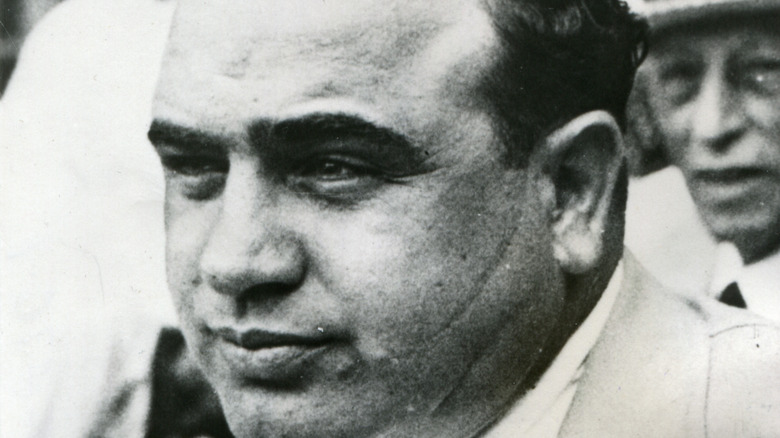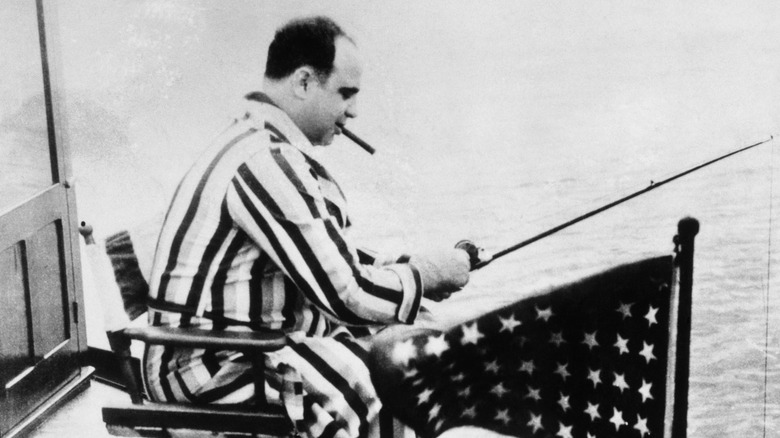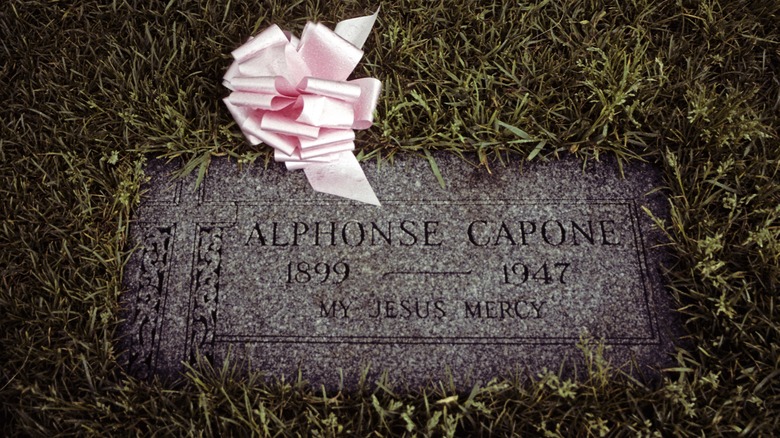What Happened To Al Capone's Body?
There was no grand homecoming for Al Capone when he emerged from his nearly eight-year stint in Alcatraz prison. The power he once wielded over his territory in organized crime wasn't there anymore — he'd been replaced as the boss of the Chicago Outfit as soon as he went away to prison. There was no opportunity to enjoy retirement either. Syphilis, contracted in the early days of his criminal career, advanced during his time behind bars, ravaging his body and his mind. The illness helped him get an early release, but his health kept declining after trading a cell in Alcatraz for his mansion in Florida.
According to Smithsonian Magazine, Capone spent his last days with the mental capacity of a 12-year-old. He would sit in his pajamas talking to long-dead friends and rivals, or fly into outbursts that his family feared would be perceived as spilling secrets. The mass production of penicillin helped slow the progression of his syphilis, but it was too late to prevent or reverse damage to his brain. A week after a joint birthday party with his granddaughter, Capone suffered a stroke, followed by a bout of pneumonia. He died on January 25, 1947, at just 48 years old.
In death, Capone returned to Chicago, Illinois — where he had become so infamous and amassed so much wealth and power — before being reportedly moved to Hillside. But his body was prepared in Miami, and his homecoming would not be the lavish send-off afforded other Mafia godfathers. Here is what happened to Al Capone's mortal remains.
His wake was held in Miami
Al Capone's official cause of death was heart failure, following on from his stroke and pneumonia. His body was prepared by Louis Rago, an undertaker flown in from Chicago who co-founded one of Chicago's first full-time funeral parlors. Capone was dressed in a double-breasted blue suit with a black tie, black and white shoes, and black silk socks. His coffin was made of bronze and cost $2,000.
Before his return to Chicago, Capone's dressed and prepared body had an open casket wake in a Miami Beach funeral home. We don't know the names of most of the mourners at that wake — many of them came and went through the back door of the venue. Capone's family was also keen to keep it a small, private affair. But a few employees of the funeral home let slip to friends that their place of work would be sending off the country's most well-known mafioso, and those friends decided to have a look for themselves.
As friends of funeral home workers, and with one of the curious intruders being a guest at the home, they had no trouble getting around the guards. They brought along a camera and got several pictures of Capone's body and floral arrangements. Their accomplice at the funeral home later convinced them to surrender the negatives to Capone's doctor and never breathe a word about the incident. But the photographer kept a set of prints, which resurfaced decades later and provided the only known images of Capone's body after death.
Capone's Chicago funeral was modest
It's not known how Al Capone was brought back to Chicago for his funeral and burial. It was reported at the time that the trip was expected to take up to two days by car and would likely be split between two drivers, but Capone's body may have made part or all of the trip by train. Decades later, it was reported in the Chicago Tribune that Louis Rago and his brother Joe brought Capone's body with them when they returned from Miami, but this was later contradicted by another article in the same paper.
However he made the trip, Capone didn't have a grand funeral with thousands of mourners a la "The Godfather." Louis H. Rago, son of the Louis of Capone's time, insisted that the funeral wasn't held in his father's funeral parlor. Instead, he said that Capone's body was collected and taken to another church for a small, private service before burial at Mt. Olivet Cemetery on February 4, 1947. He was buried near his father and brother, and gravediggers served as his pallbearers. A respectable 15 cars' worth of mourners attended, but it was a modest service, and only two policemen were present to observe the proceedings.
It's been reported that Capone's body was moved to Mt. Carmel Cemetery a few years after his burial. There is a grave marker for him there, though relocation records have been kept private. Being one of nine siblings, it's been suggested that Capone was moved to make room for his brothers and sisters in the family site at Mt. Olivet.


